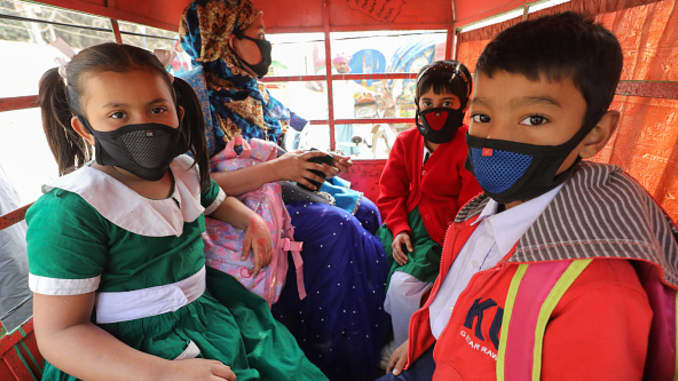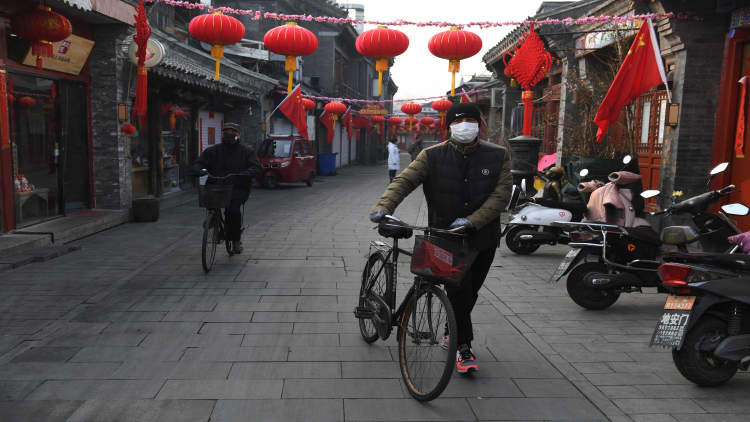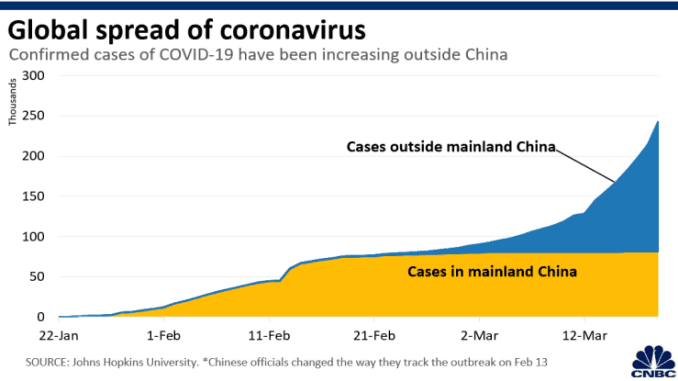More likely to get the flu than the Wuhan virus...all this panic and disruptions,,for what?
Wuhan coronavirus (2019-nCoV): What we know so far about the new virus emerging in Asia
February 6, 2020
Written ByEmily Landon, MD
Topics
A new coronavirus virus, likely first transmitted to people from animals at a market in the Chinese city of Wuhan, is making international headlines as disease detectives work to uncover what it is, how it’s transmitted, and how deadly the virus actually is.
As an
infectious disease specialist and the hospital epidemiologist at the University of Chicago Medicine, my job is to prepare for outbreaks of all sorts of illnesses — from staph infections to Ebola — while caring for patients at our academic medical center on Chicago’s South Side.
Public health officials are continuing to learn more about the Wuhan novel coronavirus, which so far has sickened five people in the U.S. While more cases are likely in this country, people shouldn’t panic.
Here’s what we know so far about the virus, also known as Wuhan 2019-nCoV.
What is a coronavirus? What is a novel coronavirus?
A coronavirus is actually the name for a set of illnesses, including the common cold and other respiratory infections. A novel coronavirus means it’s a new virus that originated in animals, but has jumped to humans. This particular virus from Wuhan is being called the
2019 novel coronavirus or 2019-nCoV.
Hospital epidemiologist Dr. Emily Landon explains how to stay safe from the new coronavirus.
Video Transcript
Where and how did the Wuhan novel coronavirus begin?
We’ve known about this particular virus shortly after a cluster of severe pneumonia cases were reported on New Year’s Eve in Wuhan, which is in the Hubei Province of China. On January 9, virologists and other public health researchers identified the strain as a novel coronavirus, which was tied to a specific “wet market” in the city of Wuhan where they sell fish and other live animals.
These markets have been known to transmit viruses before. For cultural reasons in the region, people want to see the specific animals they’re buying be slaughtered in front of them, so they know they’re receiving the products they paid for. That means there’s a lot of skinning of dead animals in front of shoppers and, as a result, aerosolizing of all sorts of things, which is why these crowded markets are common places for viruses to jump from animals to people. It’s actually how
SARS, another coronavirus, started in 2003.
How does the Wuhan coronavirus spread?
So far, there’s limited information about the Wuhan novel coronavirus, including how easy it is to spread and how dangerous it is. But we know the virus can be transmitted from person to person and it is passed by coughing and other close contact.
Close contact is a vague term that means a lot of things to different people. But in this case, it specifically means being within about six feet of someone for a prolonged period of time without wearing recommended personal protective equipment such as a disposable face mask. It could also be having direct contact with infectious secretions of someone who has a case of the virus (for example: being coughed on) while not wearing personal protective equipment.
That can sound scary, but it’s important to know that influenza is also transmitted the same way. It’s a good reminder to make sure we’re washing our hands frequently and covering our nose and mouth when we sneeze.
Is this coronavirus deadly?
The numbers of how many people have been diagnosed or how many have died are changing rapidly. Without accurate numerators and denominators, the jury’s still out. That said, we do know that hundreds of people in China have died from this virus. Based on the information I’m seeing, it looks very similar to SARS in a number of ways — except for the fact that it’s likely less deadly, but more transmittable.
Have there been cases of the Wuhan novel coronavirus cases in places other than China?
Yes. So far, cases have been reported in more than a dozen countries, including at least 11 confirmed cases in the U.S. It’s a reasonable expectation that the number will grow across the globe, due in no small part to the fact that China is a densely populated country and there was massive travel taking place for Lunar New Year celebrations that may have helped spread the virus.
What are the symptoms of the virus?
We’re still learning more about Wuhan novel coronavirus, but we know it typically causes flu-like symptoms including a fever, cough and congestion. Some patients — particularly the elderly and others with other chronic health conditions — develop a severe form of pneumonia.
Are we all at risk for catching this new coronavirus (2019-nCoV)?
Yes. It doesn’t appear anyone is naturally immune to this particular virus and there’s no reason to believe anybody has antibodies that would normally protect them.
The lack of previous experience with this pathogen is part of the reason why public health officials around the globe are working so hard to contain the spread of this particular coronavirus from Wuhan. When viruses come out like this that are both new (which means the population is highly susceptible) and can easily pass from person to person (a high transmission rate), they can be really dangerous — even if here’s a low percentage of people who die from them.
Why do some people with the Wuhan coronavirus get sicker than others?
It looks like only about 20% of people who contract this novel coronavirus actually wind up needing to be hospitalized. The other 80% get what feels like a really bad cold and they recover at home. A lot of it has to do with underlying medical conditions. People who are more vulnerable to any kind of infection — because of their age or chronic health conditions — are more at risk for getting really sick from this novel coronavirus too.
That said, some otherwise healthy people do seem to be getting more sick from this infection than we would expect. We don’t understand why that is or what might be different about those people. Thanks to the work of scientists and doctors on the ground in China, which is really nothing short of heroic, we’re learning a little more every single day.
How do you treat patients with this virus? Can you vaccinate against it?
Things like antibiotics are designed to kill bacteria, not a virus. So typically doctors can treat the symptoms, but not the virus itself. There’s no vaccine yet.
What kind of medical care do patients with the Wuhan coronavirus need?
About 80% of people who contract this new coronavirus will feel sick, but ultimately be just fine. It’s the other 20% who get really, really sick that worry so many of us in the infectious diseases field. A lot of these critically ill patients wind up needing to be hospitalized for their pneumonia-like illnesses. They typically require critical care and ventilation — special machines that help them breathe. And some need to stay on ventilators for weeks at a time. It’s that portion of patients that’s most concerning. Depending how many cases develop here in the U.S., providing that level of care for that many people over a number of weeks runs the risk of overwhelming the nation’s health care system pretty quickly.
How do you screen patients to see if they’re infected with the coronavirus?
At UChicago Medicine, our teams are following
guidelines from the U.S. Centers for Disease Control and Prevention. That means we’re asking any patient who has respiratory symptoms and a fever if they’ve traveled to the affected area in the past two weeks or been in close contact with someone with a known or suspected case.
Patients who answer yes will immediately be given a face mask and put in an isolation room, which has negative pressure to keep airborne germs inside. Then, they’ll be tested for the specific virus. Turnaround time on those lab tests is about four days. People will need to remain in isolation until they’re cleared.
We’re also instructing our clinical teams to follow standard infection control protocols. So our doctors, nurses and other clinical staff will wear gear like gowns, gloves, masks and eye shields. That’s what they’d do with anyone who has something like the flu and it’s the same steps we followed during the SARS and
MERS outbreaks. We’re also reminding everyone to make sure to wash their hands regularly and avoid touching their faces — that’s good practice any time of the year, but especially during flu season.
Should people be more concerned about the seasonal flu or the new coronavirus?
You're more likely to catch the flu than this coronavirus — in terms of what you’d be more likely to pick up if you were out running errands today. There’s widespread seasonal flu activity going on right now all around the U.S. But there’s also a lot of steps you can take to protect yourself from influenza. You can get an annual flu shot. You can take medication like Tamiflu that protects you from getting influenza after you’ve been exposed. You can cover your mouth and wash your hands to mitigate the spread. And, like clockwork, this year’s influenza strain is going to die out in the spring because it will have run its course.
The challenge with the new coronavirus from China is that we just don’t have any information to know if it can be contained, if it will run its course before the summer and disappear, or if it will have to infect a substantial part of the population before burning out.
As a country, we’re also prepared for influenza. It comes every year! But we don’t know if we’re really prepared as a country for a massive coronavirus pandemic.
Will the flu shot protect people from this new coronavirus?
Unfortunately it won’t. But it will help protect you from the flu, and the flu is what you’re more likely to catch right now.
Can drugs like Tamiflu protect patients from getting sick from 2019-nCoV?
No. Tamiflu is designed to fit into a molecule in the influenza virus, which doesn’t appear to be part of the Wuhan virus. However, there are other antiviral medications that may be helpful. We’re still learning more about whether these drugs, like Kaletra (an antiretroviral for HIV patients), will prevent people from getting sick entirely or just help people recover faster. Still, there’s a lot of hope in some of the early data we’re seeing. There are also other antivirals being evaluated at the center of the outbreak in Wuhan.
What should you do if you think you’re infected?
If you haven’t been to the affected region or been near someone who’s been the affected region, you’re likely OK. January and February are rough months for all sorts of respiratory ailments because colds and influenza are common. That said, if you meet the CDC’s criteria, reach out to your doctor right away. If you’re going to your doctor’s office or an emergency room, call ahead so someone can meet you outside to give you a facemask to help limit the spread of any germs.
Can you get tested for this coronavirus if you're worried you've been exposed?
Not right now. The test to diagnose this is new and it’s not widely available. Because there aren’t enough tests, only people who are showing symptoms of the disease
AND who are high risk for exposure can get tested. But make sure you tell your doctor of any recent travel history so they can make a decision about whether to test you.
It’s also worth mentioning that people shouldn’t be worried if they go to their doctor’s office and get tested for respiratory viruses and the results say they have a coronavirus. That’s because coronavirus is the name for a whole group of viruses, including things like the common cold. Most doctors’ offices can test for normal, everyday coronaviruses. If you see test results that say you have one, you shouldn’t worry. If you are being tested for Wuhan 2019 novel coronavirus, your doctor will be very, very specific and will be sure to walk you through any results that come back.
Is this new coronavirus virus airborne?
In infection control, we draw a line between things that are transmitted by droplets that can travel in the air briefly in respiratory droplets and things that are actually aerosolized and float around for a while. Think of droplets as small bits of fluid that you can feel and see when someone sneezes. You sneeze or cough and these droplets get on surfaces and then you touch them and get them on your hands, or they can fly right into your mouth or nose or eyes. That’s how most coronaviruses are transmitted and that’s how we think this one is too.
Aerosols are different. Think of hairspray after you use it in the bathroom. When you go back to the bathroom later, you may still be able to smell it because it’s lingering in the air. Obviously we’re learning a lot about this virus, but most coronaviruses aren’t airborne that way. Generally speaking, there may be times when some of these droplets or particles are airborne, but it’s limited.
Will wearing a facemask keep you safe from the Wuhan coronavirus virus, particularly if you're heading to an airport like O’Hare where passengers are being screened for the virus?
Wearing a facemask is one way to help protect yourself during any kind of respiratory outbreak. It can certainly help keep droplets of other people’s mucous and saliva out of your mouth and nose. However, it’s still really important you clean your hands, avoid touching your face and make sure you swap out your facemask regularly. Otherwise you’ll eventually just get whatever’s on the outside of the facemask on the inside.
Someone on my plane was coughing next to me. Should I worry I have the Chinese coronavirus?
Probably not, but you may have the flu. Thanks to the travel restrictions that are in place, you should assume most people who are coughing on planes right now don’t have this particular coronavirus. In the unlikely chance someone on your flight did have the Wuhan coronavirus, the local health department in your community will find you. If they don’t, then you weren’t exposed.
Emily Landon, MD
Dr. Emily Landon specializes in infectious disease, and serves as medical director of antimicrobial stewardship and infection control.
https://www.uchicagomedicine.org/forefront/prevention-and-screening-articles/wuhan-coronavirus






![Medical workers in protective suits help transfer the first group of patients into the newly completed Huoshenshan temporary field hospital in Wuhan in central China's Hubei Province [Xinhua via AP] Medical workers in protective suits help transfer the first group of patients into the newly completed Huoshenshan temporary field hospital in Wuhan in central China's Hubei Province [Xinhua via AP]](https://www.aljazeera.com/mritems/imagecache/mbdxxlarge/mritems/Images/2020/2/8/275aaec73ea74dc08cb7911fe8202ae9_18.jpg)